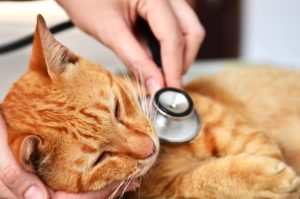How Can We Help?
Recognizing Signs of Pain and Illness in Your Cat
Part of being only semi-domesticated is the tendency for your cat to hide signs when sick or injured. Some people even speculate cat’s might worry that showing signs of pain will cause them to lose out to a more deserving animal, encouraging them to mask their symptoms. Because of these reasons, it can be very easy to miss signs that something is wrong.
Go back with me around 7,000 years to the fertile crescent, an area between the Tigris and Euphrates rivers. The sun has set, and the diurnal animals are settling in for the night. A small and very hungry hunter, Felis lybica, is slowly sneaking up a tree getting ready to spring on a song thrush. As she brings her powerful hind legs up beneath her, getting set for her attack, the branch she is balancing on breaks and she falls to the ground. The fall is only about 10 feet and of course she lands on her feet, but her landing site is full of large rocks causing her to twist and injure her right front paw. She recovers quickly and looks around for the larger predators roaming the fertile plane, such as lions and hyenas, to see if she has been noticed. Despite the pain in her paw she moves without a noticeable limp and quickly scrambles back to the abandoned fox den she calls home. For the next several days she will stay in or very close to her den only venturing outside for a drink when she is certain she is in no danger. If you watched her move it would be difficult to detect she was injured but you might note she was not grooming herself as her fur is not her usual smooth glistening coat. If you were very astute you might notice her breathing and heart rate were higher than normal. This small bundle of muscle doesn’t have the liberty to show she is injured. If she shows signs of weakness she will be targeted and become dinner for someone else.

Although this story takes place very long ago, our house cat, Felis catus, is the direct descendent of our friend above from Mesopotamia.
What are signs that your cat is not doing well?
Dr. Duncan Lascelles, an expert on pain in cats at North Carolina State University College of Veterinary Medicine, has a helpful questionnaire to determine if your cat might be “suffering in silence.”
Luckily for us, and our kitties, a panel of 19 “international veterinary experts in feline medicine” came up with a list of 25 signs “sufficient to indicate pain, but no single sign was considered necessary for it.”
If your cat is doing any of the following, he is probably hurting.
- Lameness
- Difficulty jumping
- Abnormal gait
- Reluctance to move
- Reaction to palpation [applying light pressure with the hands]
- Withdrawn or hiding
- Absence of grooming
- Playing less
- Appetite decrease
- Overall activity decrease
- Less rubbing toward people
- General mood
- Temperament
- Hunched-up posture
- Shifting of weight
- Licking a particular body region
- Lower head posture
- Blepharospasm [squinting]
- Change in form of feeding behavior
- Avoiding bright areas
- Growling
- Groaning
- Eyes closed
- Straining to urinate
- Tail flicking
Other changes that will be picked up by your veterinarian are an increased heart and respiratory rate.
It is important to know your cat and his habits well enough to notice when something changes. As always, with any pet animal, get to know your veterinarian before anything goes wrong. Preventative health care can thwart pain before it happens.

As your cat sits on her high perch overlooking her kingdom, even if it is your living room, she is still looking through the eyes of a wild predator. Her instincts haven’t changed from her untamed ancestors and she will do her best to show that nothing is wrong even in the face of significant illness. Get to know her, find what is normal for your small hungry hunter because she is a mighty beast and will show no weakness!!
References
Guidelines for recognition, assessment and treatment of pain: WSAVA Global Pain Council members and co-authors of this document: Mathews K, Kronen PW, Lascelles D, Nolan A, Robertson S, Steagall PV, Wright B, Yamashita K. J Small Anim Pract. 2014 Jun;55(6):E10-68.
Behavioural Signs of Pain in Cats: An Expert Consensus. Merola I, Mills DS. PLoS One. 2016 Feb 24;11(2):e0150040.

